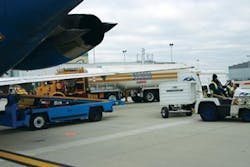Growing up on a dairy farm in a depression-era family, Steve Thomas, CEO of Emery Air, Inc., learned his methods of conservation at an early age. His family saved bent nails, reused and/or repaired everything and never threw anything away. Over the years, Thomas restored antique airplanes and cars, so the idea of rebuilding ground support equipment was a natural thought that made economic sense.
“In a perfect world we’d have all the various types of GSE equipment available to serve all our wants,” Thomas says. “We can’t afford that.” Instead of flipping through catalogs to find new equipment, Thomas and a few members of his staff attend auctions and look for equipment other companies are looking to put out to pasture. “We’ll buy derelict equipment, stuff that other people basically throw away or retire, then we restore it, make it like new and we find that we have a lot less investment in it than if we were going to go out and buy one.”
They’re not looking for any pile of steel that may or may not run again; there are certain character traits that are required before a purchase is made. Thomas usually looks for equipment that is in poor condition, but still has available replacement parts; he doesn’t prefer any particular brand over another. “This [equipment] can be purchased at a fraction of new or used/overhauled units,” Thomas says. “The goal is to end up with a piece of equipment at a total cost significantly less than any other choice available, enhancing our ability to expand the services we provide to our customers sooner rather than later.”
After the equipment is repaired and operational, Thomas slaps a few fresh coats of white paint on it and adds a few customized Emery Air decals before it joins the fleet.
“Employees Love It”
Refurbishing equipment serves a number of purposes at Emery Air, most notably increasing employee morale and creating full-time jobs for mechanics.
“[Employees] will see a ‘piece-of-junk’ — in some peoples minds — show up, and they know when we’re done with it, it will be an attractive piece of equipment that they’ve always wanted,” he says. According to Thomas, the employees enjoy watching the equipment transform from junk into something they’re not only proud of, but makes their job easier.
The restoration also helps Thomas defend Emery’s staff of GSE mechanics. The mechanics not only maintain all of his GSE equipment, but he always has a side project to keep them busy when nothing is broken down.
By staffing full-time mechanics, when a piece of equipment goes down, Thomas isn’t scrambling to locate a part-time mechanic. He can use his manpower to fix it right away. “It would be hard to justify having mechanics [specifically] for when stuff breaks,” Thomas says. “We always have a project vehicle in the shop and that pays their wages, yet they’re always around.” Emery has a 4,600 square-foot GSE shop designated for restoration and maintenance.
No Ordinary Tug
Always looking to save a little on the bottom line, Thomas has made an unlikely addition to his GSE inventory. By employing a technique he has found successful at his fixed based operation at Poplar Grove Airport, he has promoted a golf cart from a means of transportation to a light weight tug.
“Typical aircraft or baggage tugs are very expensive,” Thomas says. “The ramp is clean, it’s flat [and] it’s a good hard surface. An electric golf cart makes perfect sense for a fraction of the money. With electric [vehicles], you’ve got power no matter how slow you’re going whereas anything with a piston engine, you’ve got to have RPM to generate power. An electric golf cart has got the same torque even if you’re just creeping along.”
Thomas has already begun retrofitting two passenger golf carts with a hitch, and toolbox to store chocks, cones and other tools needed on the ramp. He’s also looking into adding a towbar carrier in the near future.
Thomas remains optimistic that his E-Z Go is going to save wear and tear on the “more expensive” GSE vehicles. “We’ve used golf carts for years at Poplar Grove Airport for towing light airplanes, twins, single-engine airplanes and it works real well,” Thomas says.
Emery Air has looked into refurbishing a used tug, but the cost benefits have been hard to overlook. “A used tug is going to be $5,000-8,000 dollars; we’ll have $2,000-2,500 in this golf cart. It’s a huge [difference] and it’s lower maintenance,” Thomas says. “The electric golf cart is dirt simple, there’s not a lot of moving parts and its low maintenance.”





